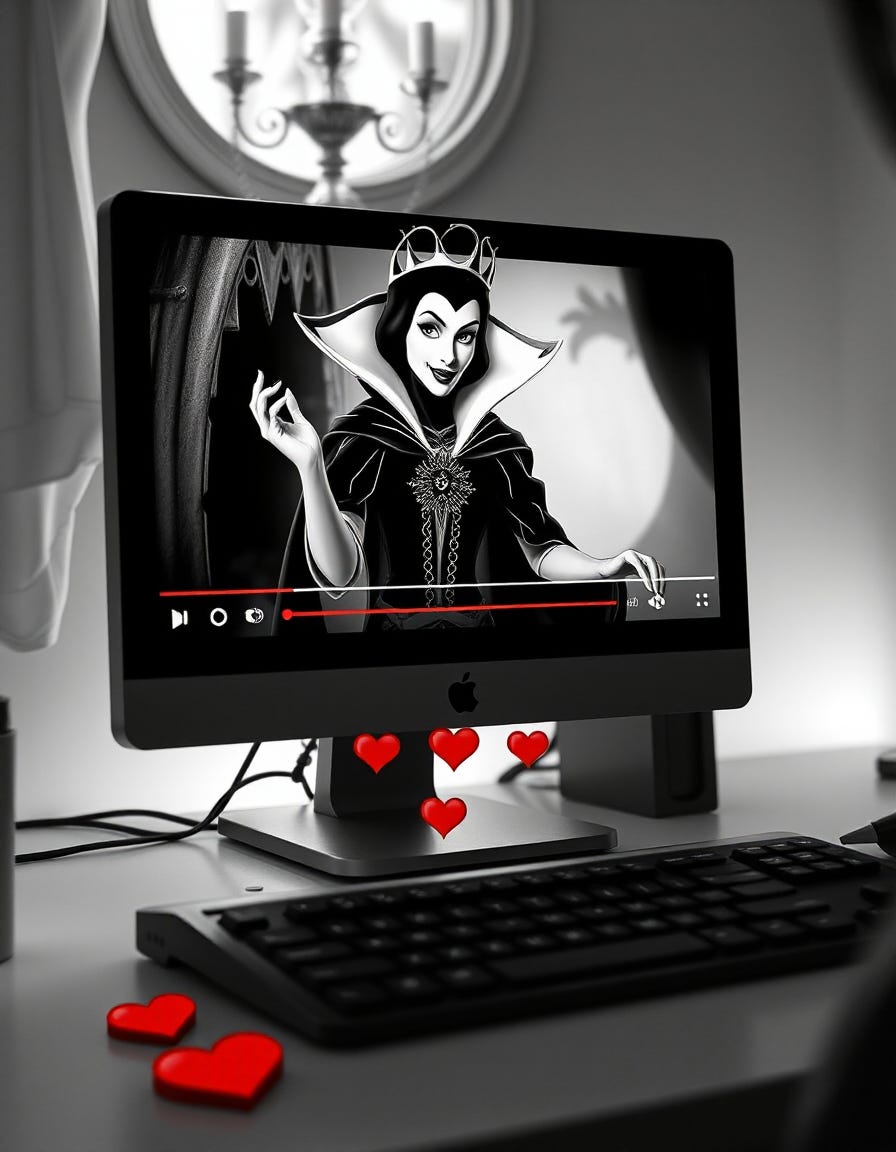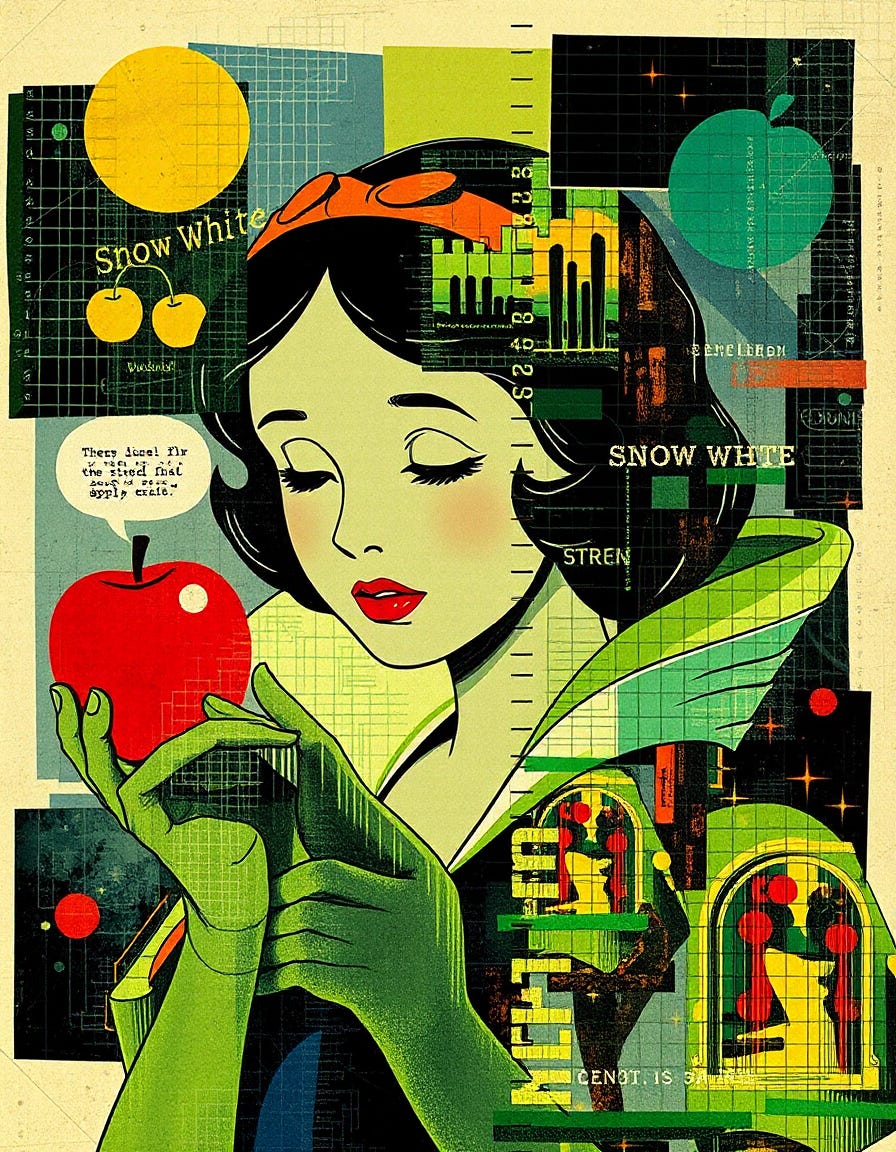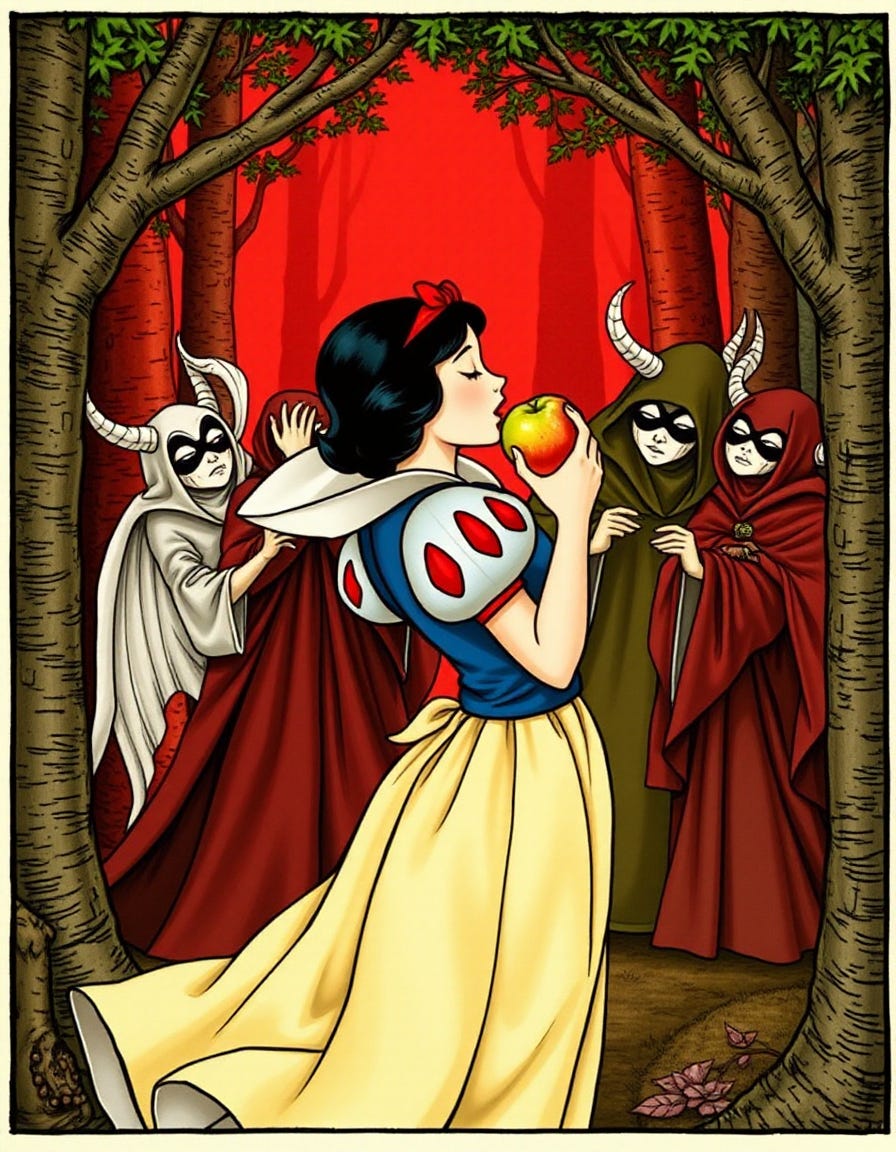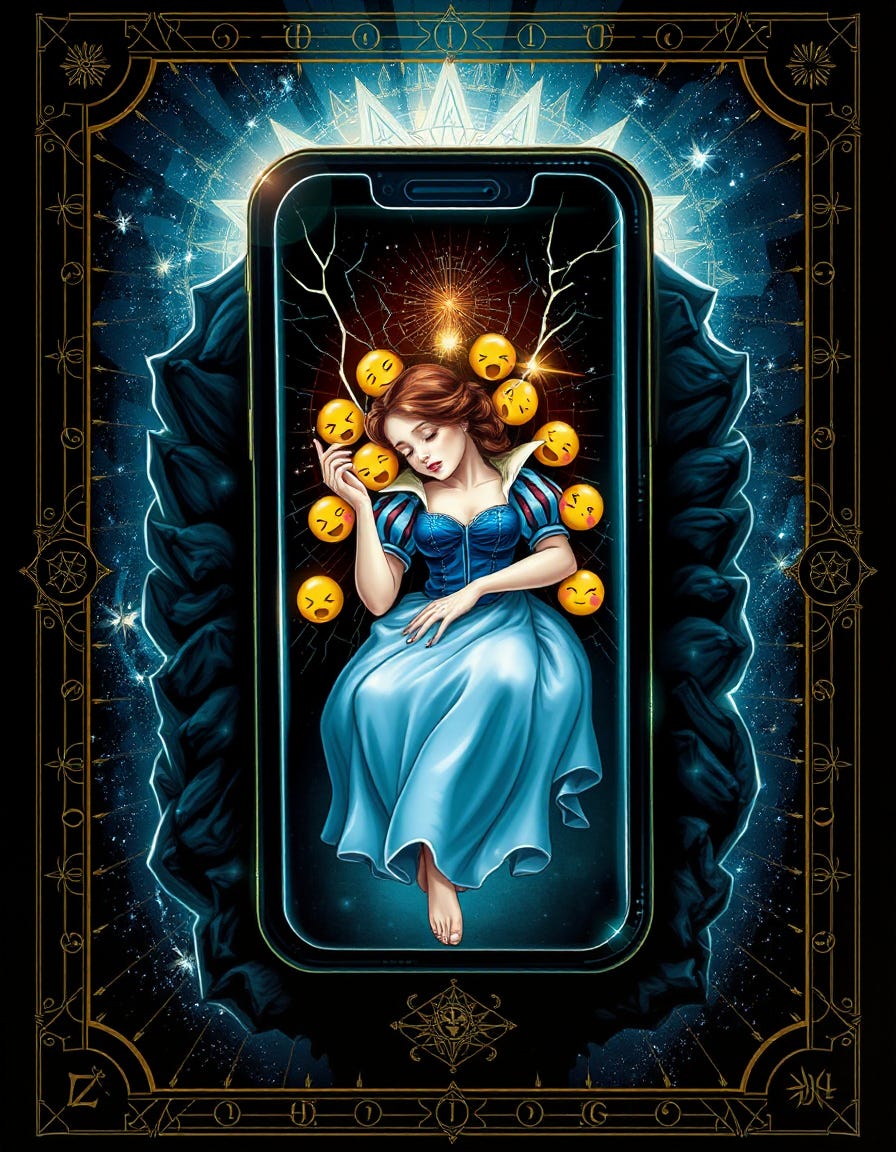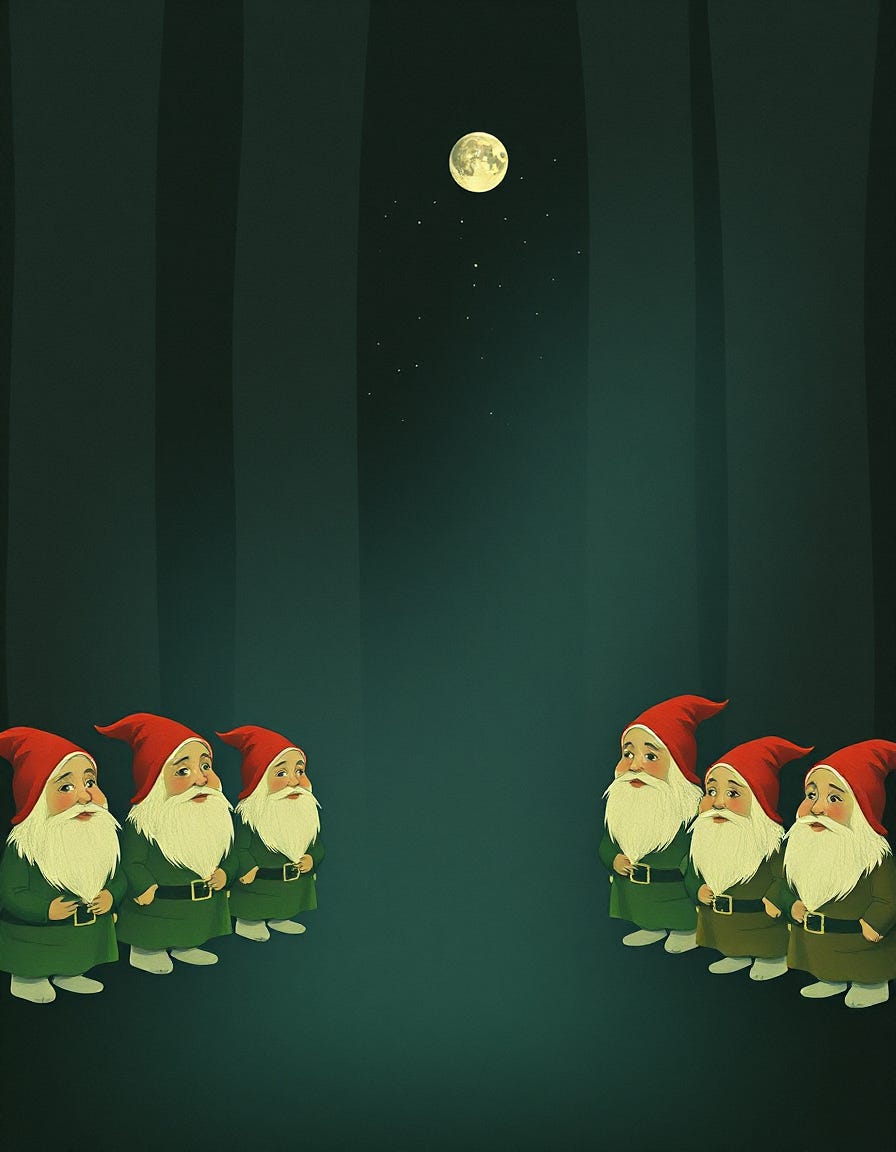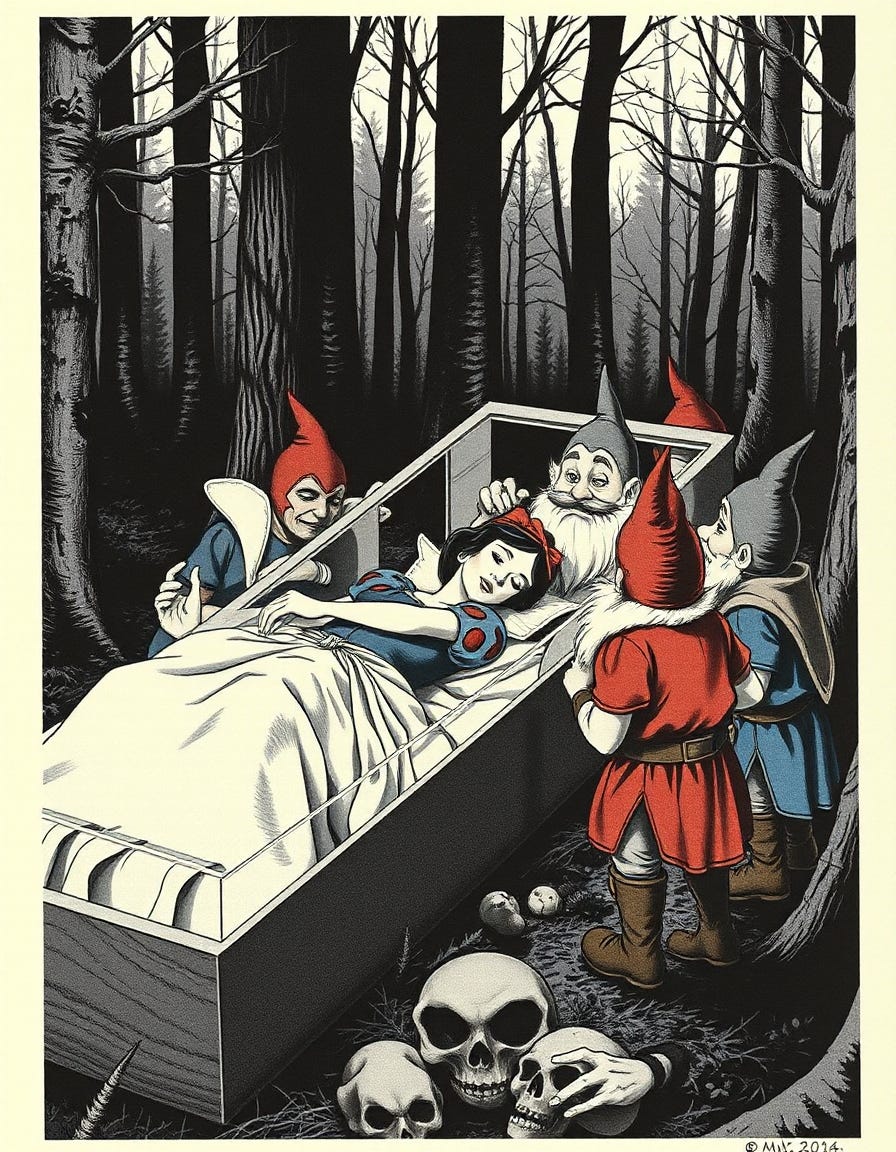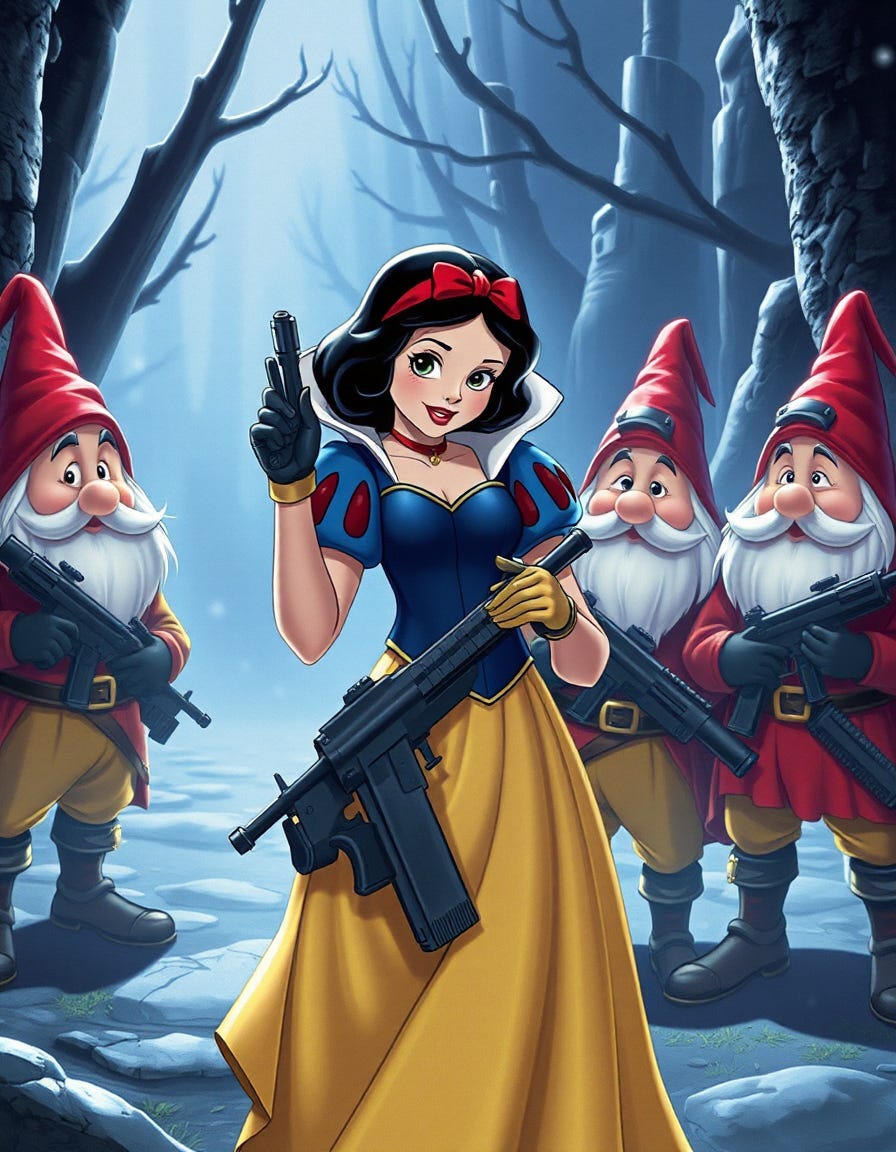Scroll, Sin, Repeat: You’re Not Doomscrolling—You’re Under a Spell pt.1
Rewriting the Myth of Snow White through Media Magick & Psychology
In an age of infinite scroll and algorithmic seduction, fairy tales are no longer bedtime stories—they are blueprints for awakening. This essay reinterprets Snow White as a mythic allegory for digital dissociation, inner fragmentation, and the possibility of re-integration through rhythm, ritual, and archetypal inquiry.
Drawing from Internal Family Systems (IFS), Jungian psychology, Reichian somatics, and media ecology, it maps the Seven Dwarves onto the seven energy systems, reframing them as inner guardians of repressed energies and symbolic initiators of the self.
The poisoned apple becomes a metaphor for algorithmic enchantment—content engineered to numb and seduce. The glass coffin becomes the glowing screen. But the trance, once understood, can be broken—not by a prince, but through embodied ritual, compassionate self-recognition, and collective rhythm. Through muscular bonding, myth remixing, and conscious participation in our symbolic lives, we reawaken.
This is not a return to the village—but a re-entry into the body, into community, and into a new mythic operating system where even memes become mirrors, and every scroll contains the possibility of spellbreaking. Each time one person snaps out of the trance and reaches for a hand instead of a device, the spell weakens for all.
The Poisoned Apple of Algorithmic Enchantment
Once upon a time, a young woman took a bite of a shiny red apple and fell into an enchanted sleep. Today, we take tiny metaphorical bites every time we tap a glowing screen. Each swipe or click can be a sweet morsel that lulls us further into a waking slumber.
Mirror, mirror in our pocket – the modern smartphone – constantly reflects back what we want to see (or what the algorithm wants us to see). Like Snow White’s evil Queen consulting her magic mirror for validation, we too seek answers from an eerily personalized feed.
The fairytale apple was poisoned with a spell of unconsciousness; our digital apples can be just as bewitched, engineered to entrance us with endless juicy content. In Snow White’s story, one bite is all it takes – she collapses, powerless, sealed in a glass coffin. In our world, it’s rarely a single bite; it’s the gradual algorithmic enchantment that catches us. Scroll by scroll, we drift into a passive trance. Hours vanish as we lie in a dreamy half-life, spellbound by infinite feeds.
That hypnotic state has been called the “algorithmic coma” or doomscrolling trance – a real-life sleeping spell induced by dopamine, blue light, and bite-sized memes. The beautiful poison is that it feels nourishing in the moment (just one more bite, one more update), but leaves us mentally cloudy and emotionally numb. We become Snow White with glazed eyes, awaiting something – or someone – to jolt us awake.
Yet embedded in Snow White’s fairy tale is not just a warning about seductive illusions, but a clue to breaking them. The heroine doesn’t awaken on her own; she’s supported by seven unlikely allies(dwarfs/chakras/selves). In a world of curated illusions and viral temptations, we too might ask: Who or what are our seven allies/selves? And how can we enlist them to break the modern spell? The answer lies in looking inward – and a bit sideways at the culture around us – to recognize the selves we’ve forgotten.
Seven Dwarves, Seven Selves: Meeting the Inner Fragments
Snow White was never really alone. In her exile she found the seven dwarves – quirky, overlooked little beings who ultimately guard and care for her. Traditionally they have names like Sleepy, Grumpy, Happy, Sneezy, Bashful, Doc, and Dopey, each one embodying a distinct trait. On a surface level, they’re comic relief. Symbolically, they’re a brilliant portrayal of our sub-personalities – the many small selves living inside each of us. Depth psychologists like Carl Jung recognized that we are not monolithic; we host a whole cast of characters in our psyche. Snow White’s dwarves can be seen as facets of her own self (and by extension, ours), often working unseen in the mines of the unconscious.
When life’s pressures or a toxic culture put us under a spell, these inner characters can scatter.
Imagine your Sleepy side (the part that just wants to shut down) taking over when you’re overstimulated, or Grumpy (your anger, your boundaries) flaring at every provoking tweet.
If our inner dwarves are out of sync – one dozing off, another flying into a rage, others hiding – our Snow White self (the wise, centered part of us) can’t function fully. We become internally fragmented, easy prey for whatever shiny illusion promises comfort to that specific fragment.
It’s as if each dwarf is susceptible to a different lure: vanity for one, fear for another, distraction for the next. Internal fragmentation makes us vulnerable to external manipulation.
The key is not to banish these selves/energies but to befriend and integrate them. In the tale, Snow White lives in harmony with the seven miners; she honors their unique personalities (even the grouchy and silly ones) and receives their protection in return. In psychological terms, we’re talking about embracing the discarded or shamed parts of ourselves.
A Jungian approach invites us to bring the dwarves out of the shadows; a modern therapist might call it compassionate inquiry – gently asking each part what it needs, acknowledging its pain or its purpose. Instead of viewing, say, our bashfulness or our anger as a “problem,” we learn to listen to it.
Each dwarf has gifts to offer when accepted: even anger (Grumpy) can become a force of truth-setting and boundary-protection, and silliness or intoxication (Dopey) can carry creative inspiration.
Twentieth-century psychologist Wilhelm Reich – known for linking bodily energy and emotion – might note that Snow White’s deathlike stupor reflects what happens when natural energies (like grief, rage, or sexual desire) are poisoned by repression.
The wicked Queen in the story is an image of envy and control; in our lives, she resembles all the forces that shame or suppress our authentic feelings.
The result is internal paralysis. Reich’s insight was that what we repress doesn’t disappear – it festers or turns against us. The very aspects of ourselves that society deems “taboo” (our raw eroticism, our fierce anger, our wild joy) become sources of shame that keep us disempowered. Snow White’s poisoned apple could well symbolize the culturally induced shame that sends our vitality into a coma.
How do we break that curse? By embracing the full range of our being. Think of each dwarf as an energy or emotion we’ve been taught to minimize: our sleepiness (fatigue or numbness), our grumpiness (righteous anger), our happiness (childlike joy), our sneezy, messy bodily self (the raw, unfiltered physicality we often hide), our bashfulness (tender vulnerability), our inner Doc (intellect and intuition), and our dopey, goofy side (innocent curiosity and yes, even altered states of consciousness). Rather than let these sub-selves operate unchecked or in isolation, we invite them into a conscious circle.
We name them, honor them, maybe even dance with them. In doing so, what was once a source of secret shame transforms into a source of power. As one modern psychospiritual guide puts it, by naming these energies we turn “silent sources of shame into conscious choices or energies we can shape.”
Instead of Snow White being at the mercy of an unsolicited poison, she (we) can take a knowing bite of life – owning every aspect of ourselves, even the “taboo” ones, and metabolizing their energy on our own terms. This kind of inner alchemy is how the princess becomes sovereign.
The story hints at this integration: Snow White in her glass coffin is ultimately preserved and protected by the devoted dwarves until she can awaken. In practice, our fragmented parts become our protectors once we approach them with compassion. We develop an inner coalition of allies. Jung might call this the process of individuation – reclaiming the lost pieces of the psyche – and indeed Snow White, after reuniting with her seven, emerges from her coffin as a whole and awakened self.






